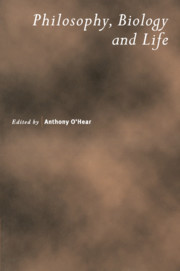Book contents
- Frontmatter
- Contents
- Preface
- Notes on Contributors
- Transcending the Emergence/Reduction Distinction: The Case of Biology
- Other Histories, Other Biologies
- The Ontogenesis of Human Identity
- Souls, Minds, Bodies and Planets
- Evo-devo: A New Evolutionary Paradigm
- Is Drift a Serious Alternative to Natural Selection as an Explanation of Complex Adaptive Traits?
- Evolution and Aesthetics
- The Problems of Biological Design
- Are there Genes?
- Folk Psychology and the Biological Basis of Intersubjectivity
- The Loss of Rational Design
- Under Darwin's Cosh? Neo-Aristotelian Thinking in Environmental Ethics
- The Cultural Origins of Cognitive Adaptations
- Name Index
Is Drift a Serious Alternative to Natural Selection as an Explanation of Complex Adaptive Traits?
Published online by Cambridge University Press: 07 May 2010
- Frontmatter
- Contents
- Preface
- Notes on Contributors
- Transcending the Emergence/Reduction Distinction: The Case of Biology
- Other Histories, Other Biologies
- The Ontogenesis of Human Identity
- Souls, Minds, Bodies and Planets
- Evo-devo: A New Evolutionary Paradigm
- Is Drift a Serious Alternative to Natural Selection as an Explanation of Complex Adaptive Traits?
- Evolution and Aesthetics
- The Problems of Biological Design
- Are there Genes?
- Folk Psychology and the Biological Basis of Intersubjectivity
- The Loss of Rational Design
- Under Darwin's Cosh? Neo-Aristotelian Thinking in Environmental Ethics
- The Cultural Origins of Cognitive Adaptations
- Name Index
Summary
‘There are known knowns; there are things we know we know. We also know there are known unknowns; that is to say we know there are some things we do not know. But there are also unknown unknowns—the ones we don't know we don't know.’
—Donald Rumsfeld, 2003, President George W. Bush's Secretary of Defense, on the subject of the U.S. government's failure to discover weapons of mass destruction in Iraq
Gould and Lewontin's (1978) essay, ‘The Spandrels of San Marco’ is famous for faulting adaptationists for not considering alternatives to natural selection as possible evolutionary explanations. One of the alternatives that Gould and Lewontin say has been unfairly neglected is random genetic drift. Yet, in spite of the article's wide influence, this particular suggestion has not produced an avalanche of papers in which drift is considered as an explanation of complex adaptive features such as the vertebrate eye. The reason is not far to seek. Biologists whose adaptationism remained undented by the Spandrels paper continued to dismiss drift as an egregious nonstarter. And even biologists sympathetic with Gould and Lewontin's take-home message—that adaptationists need to pull up their socks and test hypotheses about natural selection more rigorously—have had trouble taking drift seriously. Both critics and defenders of adaptationism have tended to set drift to one side because they are convinced that complex adaptive traits have only a tiny probability of evolving under that process. The probability is not zero, but the consensus seems to be that the probability is sufficiently small that drift can safely be ignored.
- Type
- Chapter
- Information
- Philosophy, Biology and Life , pp. 125 - 154Publisher: Cambridge University PressPrint publication year: 2005



